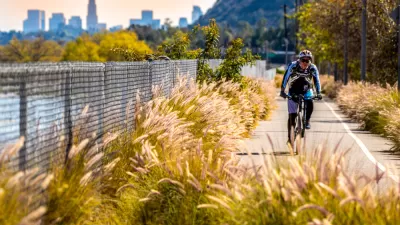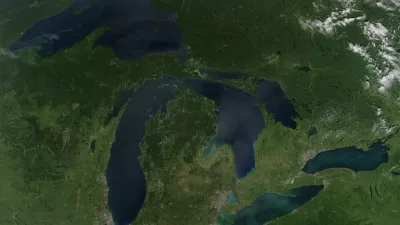At the recent ASLA Conference in San Diego, a panel of noted landscape architects discussed whether New York City's hit park The High Line is a replicable model for other cities.
The panel, also covered by Planetizen earlier in the week, included landscape architects Martha Schwartz, FASLA; Laurie Olin, FASLA; Charles Waldheim, chair of the landscape architecture department at Harvard University; and Maurice Cox, former mayor of Charlottesville, Virginia.
John King, urban design critic at the San Francisco Chronicle, asked the panel if every city should be seeking ways to repurpose their old infrastructure like The High Line does:
"Olin thinks that cities trying to copy the High Line just to bring in tourists will shoot themselves in the foot. 'People need to build cities for themselves. Paris was not built for tourists.' But he said Americans really need to learn to live in dense environments because, in effect, density becomes the key attraction. Waldheim agreed, adding that it should be about 'building communities first.' Cox seemed to offer something similar, arguing that 'every city already has a High Line' - it's usually a 'toxic brownfield site' but the issue is 'finding the uniqueness of that particular place, and using it fuel development.' The High Line was a product of citizen advocacy and action. 'It wasn't Mayor Bloomberg's idea. He opposed it, and didn't see it as a tourist draw. There are thousands of High Lines in America.'"
Much more coverage of the panel over at ASLA's blog, The Dirt.
FULL STORY: Is There a New American City?

Americans May Be Stuck — But Why?
Americans are moving a lot less than they once did, and that is a problem. While Yoni Applebaum, in his highly-publicized article Stuck, gets the reasons badly wrong, it's still important to ask: why are we moving so much less than before?

Using Old Oil and Gas Wells for Green Energy Storage
Penn State researchers have found that repurposing abandoned oil and gas wells for geothermal-assisted compressed-air energy storage can boost efficiency, reduce environmental risks, and support clean energy and job transitions.

Placekeeping: Setting a New Precedent for City Planners
How a preservation-based approach to redevelopment and urban design can prevent displacement and honor legacy communities.

San Francisco’s Muni Ridership Grew in 2024
The system saw its highest ridership since before the Covid-19 pandemic, but faces a severe budget shortage in the coming year.

Colorado Lawmakers Move to Protect BRT Funding
In the face of potential federal funding cuts, CDOT leaders reasserted their commitment to planned bus rapid transit projects.

Safe Streets Funding in Jeopardy
The Trump administration is specifically targeting bike infrastructure and other road safety projects in its funding cuts.
Urban Design for Planners 1: Software Tools
This six-course series explores essential urban design concepts using open source software and equips planners with the tools they need to participate fully in the urban design process.
Planning for Universal Design
Learn the tools for implementing Universal Design in planning regulations.
Heyer Gruel & Associates PA
City of Moreno Valley
Institute for Housing and Urban Development Studies (IHS)
City of Grandview
Harvard GSD Executive Education
Salt Lake City
NYU Wagner Graduate School of Public Service
City of Cambridge, Maryland




























